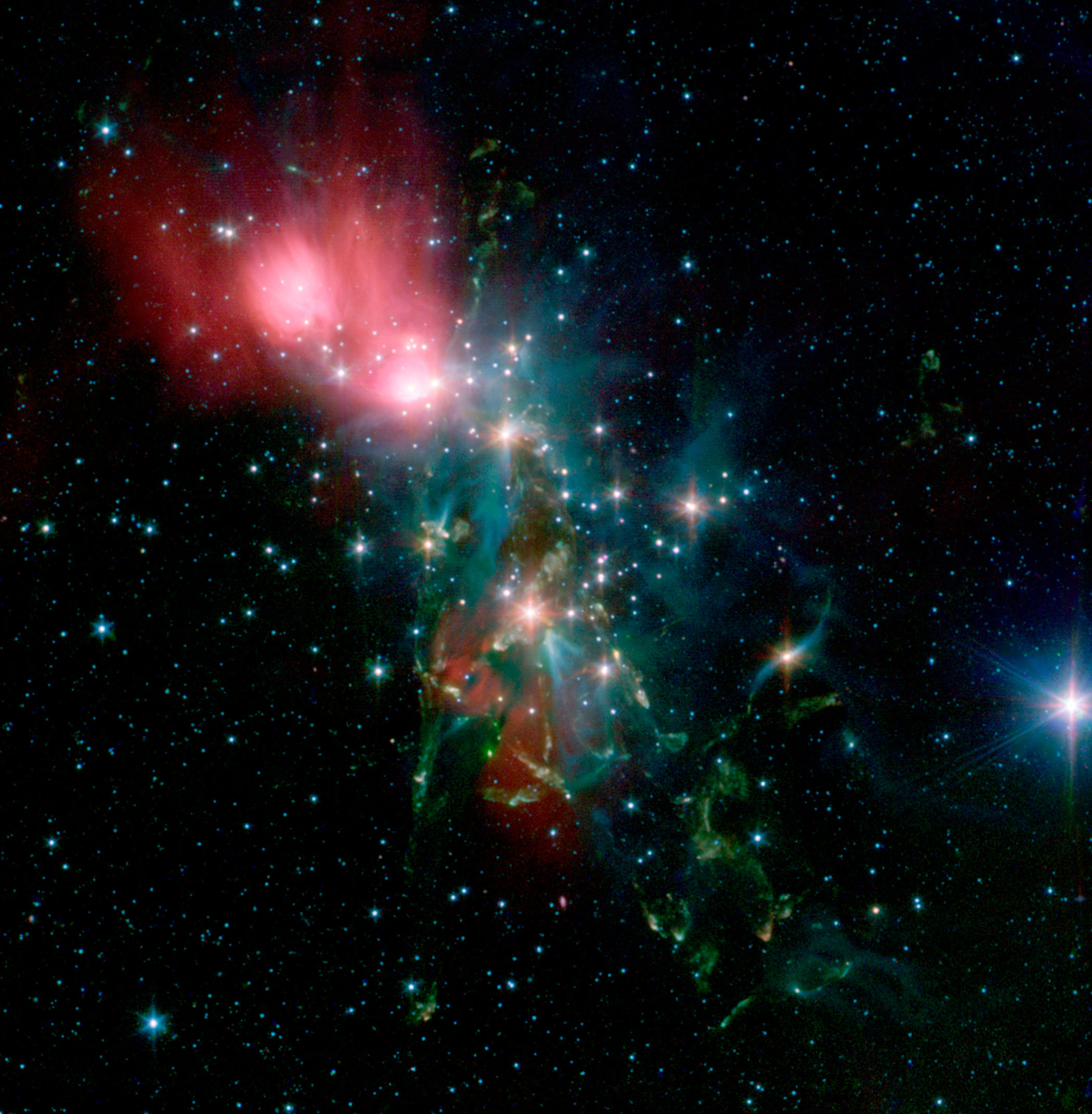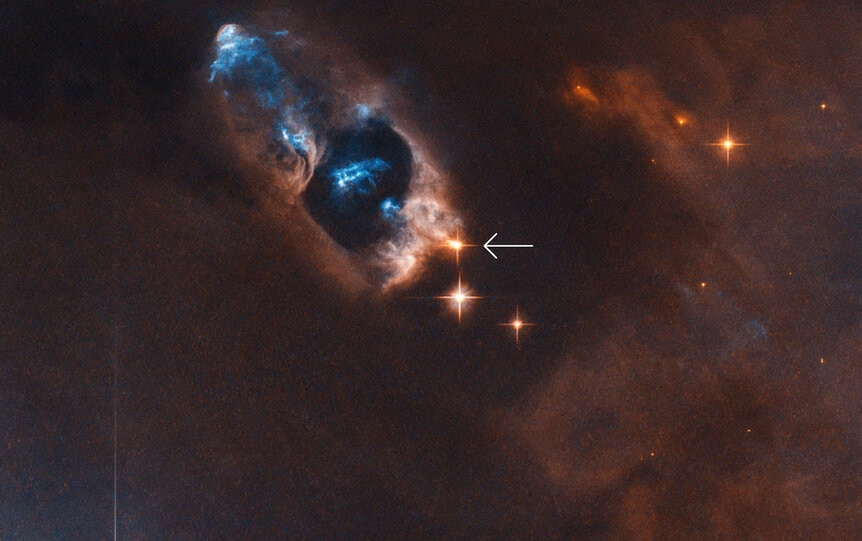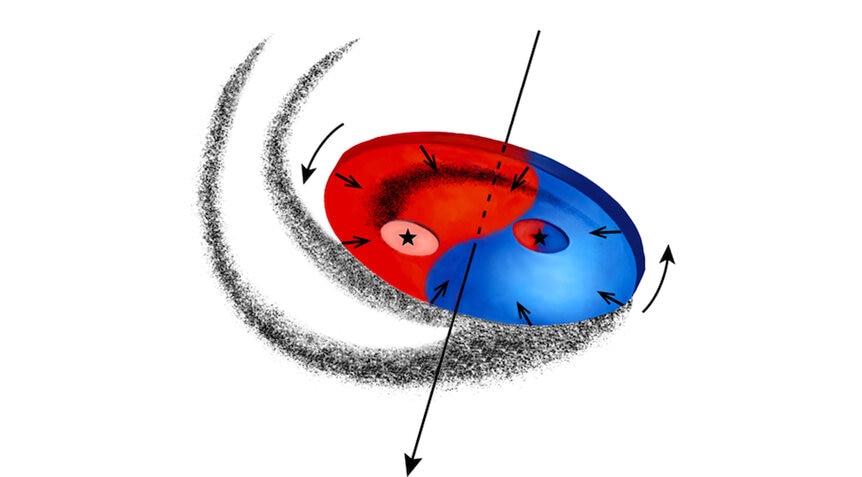Create a free profile to get unlimited access to exclusive videos, sweepstakes, and more!
A baby binary star may be forming three different planetary systems around it
SVS 13 is a binary star overachiever.

I have being doing astronomy for a long, long time, and I still think one of the coolest things we can do now is see stars literally forming, coalescing from disks of gas and dust around them.
Even cooler than that, we can see planetary systems forming around them.
But there are still scales of cool within this framework, and somewhere near the top is the binary star SVS 13. Why? Well, not only is it a young star system still forming while it’s forming planets, it’s also spitting out jets of gas trillions of kilometers long at the same time.
And the kicker? It’s not just forming planets around each of the two stars separately, it may also form planets that orbit farther out around both.
That means these two stars may be forming three distinct planetary systems. I’m not even sure I would’ve thought that was possible.
SVS 13 is about a thousand light-years from Earth — relatively close in terms of our 120,000-light-year-wide galaxy — and is part of the huge Perseus Molecular Cloud, a vast, dense, cold cloud of gas and dust. Parts of this cloud are collapsing to form stars, and in some places they light up the material around them. NGC 1333 is an extremely photogenic example of this, where we see dozens of stars being born.
SVS 13 looks like one star to visible-light telescopes but careful observations in the radio part of the spectrum using the Very Large Array (or VLA) show it’s a binary star, with two low-mass stars orbiting one another about 14 billion kilometers apart, or three times the Sun-Neptune distance. The two components are called VLA 4A, which is very roughly ¼ the Sun’s mass, and VLA 4B, which is about 0.6 solar masses.
The stars sit at the base of a small cavity carved in the gas and dust of NGC 1333, with several spots of gas inside the cavity emitting light. These are caused by beams of material blown out by the forming stars like water from a firehouse; these are generically called Herbig-Haro Objects and the ones seen near SVS 13 specifically are called HH 7 through 11. So it’s pretty clear the two stars are not only young but still in the formation process.
New observations using VLA [link to paper] probed the binary system on very small scales and the results were pretty dang surprising. VLA is sensitive to the radio light emitted by warm dust and gas surrounding these stars, and the astronomers found clear evidence that each of the two stars has a disk of dust and gas around it, with VLA 4A’s disk being about 4 billion km across and the one around 4B about 3 billion. The amount of material around 4A is enough to easily make a thousand Earths (or a few Jupiters) and the disk around 4B, though smaller, could have twice that much material.
That right there is pretty amazing. We know that low-mass stars like these, called red dwarfs, not only are capable of forming planets but tend to make smaller, rocky planets like Earth versus big gas giants like Jupiter. The nearby very low-mass star TRAPPIST-1 has seven Earth-sized planets, all huddled closer to the star than Mercury orbits the Sun. So it seems like a good bet that both of those stars may each get their own planetary system when things settle down.
Interestingly indeed, the astronomers also detected organic molecules, complex carbon-based molecules, in this material around the stars. While this doesn’t indicate life, these molecules may be the precursors for life, the kinds of building blocks life on Earth started with. In a few billion years, who knows what that will lead to?
The VLA observations also show that the two stars are embedded in a much bigger disk 150 billion kilometers across. The disk is still in the early stages of formation. Amazingly, highly detailed observations of this system have been taken for 30 years, and over that time the stars have moved enough in their orbits around one another to actually see them move. The amount of motion depends on their orbital velocity, which depends on the gravity and therefore the mass of the system, which allowed the astronomers to get the combined mass of the stars, gas, and dust: About the same as the Sun’s mass. All this complexity from just that much material!
But there’s more. The total mass of just the gas and dust in that bigger disk is about 5% that of the Sun, but don’t be fooled; that’s a lot of material, enough to make 50 Jupiters. The observations also show a spiral pattern to the disk, which is very interesting indeed; that is sometimes the calling card of an embedded planet whose gravity disturbs the material around it. However, it’s also possible, maybe even more likely, that it’s an outcome of material from the surrounding gas cloud falling onto the two stars themselves — this has been seen before in a forming binary system. As the stars orbit each other the infalling material can get wound up like a pretzel.
The current observations aren’t quite enough to distinguish between the two. It depends on a lot of parameters like the masses of the stars, which are hard to determine with enough certainty. Future observations may be able to nail those down.
Since the big disk is still coalescing it may yet be able to form planets that circle both stars, called circumbinary planets — think Tatooine as an example.
And that’s the possibility that fascinates me so. When they are done forming in a few million years, each of those two stars could have their own planets, and another set of planets orbiting them both much farther out. Three sets of planets! It wouldn’t be possible for all three to have Earth-like planets, since the ones farther out will be very cold, like Neptune or Pluto, but still. Even the thought of such a system is tremendously exciting.
I love that all the bizarre and fantastical planets I read about in sci-fi novels as a kid could indeed be real, and even some no one ever thought of before. And we can see them as they form.
Nature really can be more clever than we are. And it tells amazing stories.


![The two stars of the binary system [BHB2007] 11 are in the process of forming, drawing material from the disk surrounding both via a pair of filaments, wound up due to the motion of the stars around each other. Credit: ALMA (ESO/NAOJ/NRAO), Alves et al.](/sites/syfy/files/styles/scale_600/public/alma_binarystars.jpg)


























